Chapter 12.12: Islamic Art: Early Period (c. 640 – 900 C.E.)
After Muhammad’s death in 634, there were four caliphs, later referred to by the Sunni as “rightfully guided,” who succeeded Muhammad. However, from 656, there were conflicts over succession, and two civil wars (656-661 and 680-692) broke out within the community of Muslims. Out of these wars emerged the Umayyad Dynasty, whose capital was Damascus in modern-day Syria. Responsible for the first great monuments of Islamic art and architecture, Umayyad rulers built the Dome of the Rock in Jerusalem, the Great Mosque of Damascus, and the so-called Desert Palaces in Syro-Palestine. The Umayyads ruled as caliphs until 750 C.E. when they were overthrown by the Abbasids. The Abbasids, like the Umayyads before them, ruled as caliphs over much of the Islamic world until 861. Their capital was at Baghdad, and later they ruled from the palace-city of Samarra in Iraq for parts of the ninth century. After 861, the Abbasids lost control of large parts of their empire through a series of uprisings in which provincial governors asserted their independence. A series of local dynasties, such as the Aghlabids (800-909) and Tulunids (868-905) in North Africa, and the Buyids (945-1055) in Central Asia, emerged and ruled, developing regional artistic styles.
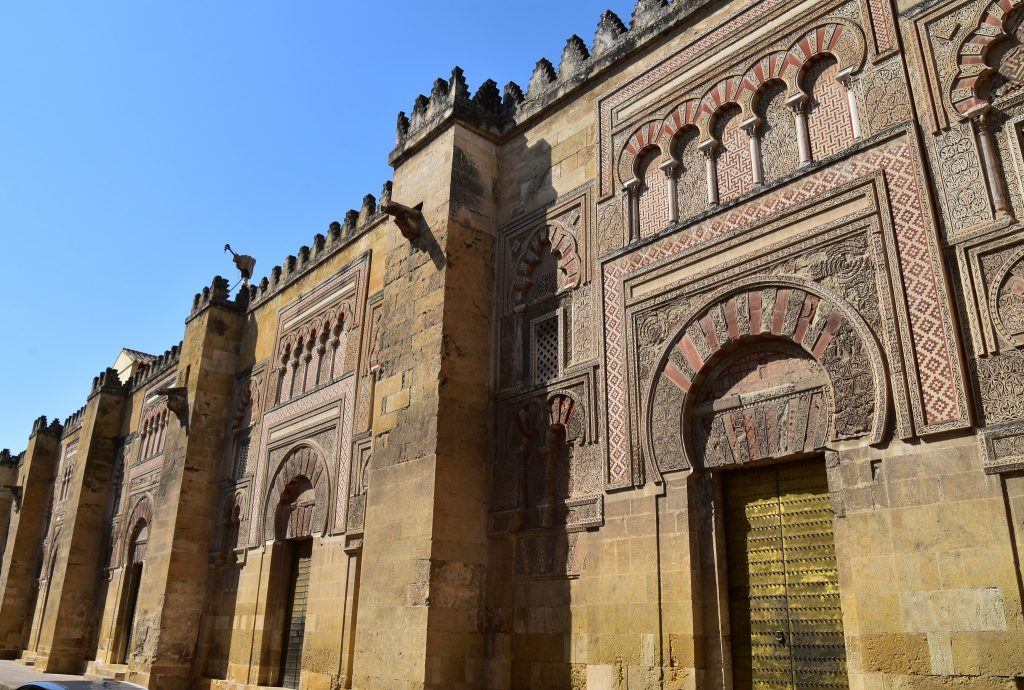
Video
Kairouan (UNESCO) (2:58)
The Great Mosque of Cordoba
Known locally as Mezquita-Catedral, the Great Mosque of Cordoba is one of the oldest structures still standing from the time Muslims ruled Al-Andalus (Muslim Iberia including most of Spain, Portugal, and a small section of Southern France) in the late 8th century. Cordoba is a two-hour train ride south of Madrid and draws visitors from all over the world.
Temple/Church/Mosque/Church
The buildings on this site are as complex as the extraordinarily rich history they illustrate. Historians believe that there had first been a temple to the Roman god, Janus, on this site. The temple was converted into a church by invading Visigoths who seized Cordoba in 572. Next, the church was converted into a mosque and then completely rebuilt by the descendants of the exiled Umayyads—the first Islamic dynasty who had originally ruled from their capital Damascus (in present-day Syria) from 661 until 750.
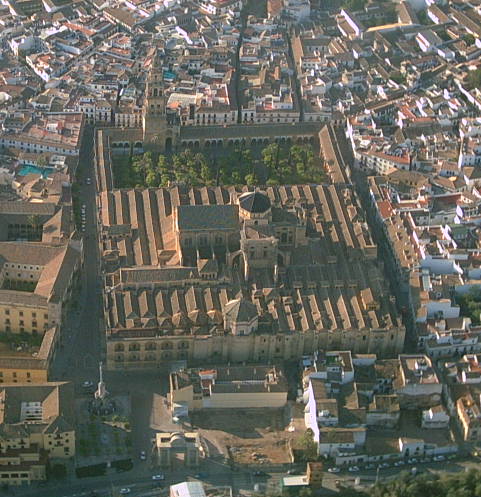
A New Capital
Following the overthrow of his family (the Umayyads) in Damascus by the incoming Abbasids, Prince Abd al-Rahman I escaped to southern Spain. Once there, he established control over almost all of the Iberian Peninsula and attempted to recreate the grandeur of Damascus in his new capital, Cordoba. He sponsored elaborate building programs, promoted agriculture, and even imported fruit trees and other plants from his former home. Orange trees still stand in the courtyard of the Mosque of Cordoba, a beautiful, if bittersweet reminder of the Umayyad exile.
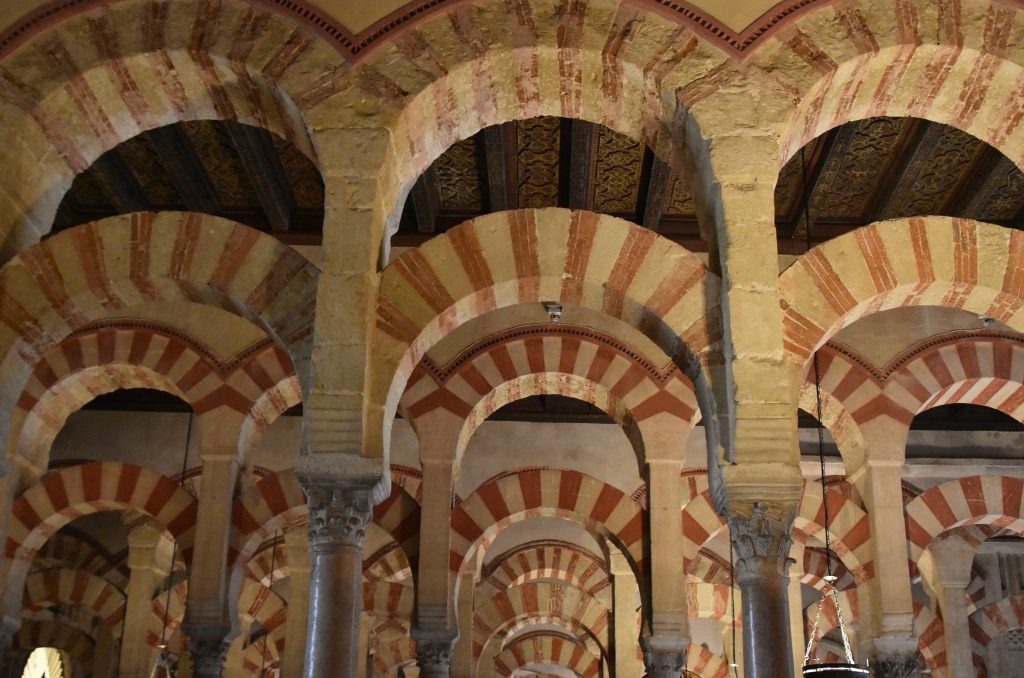
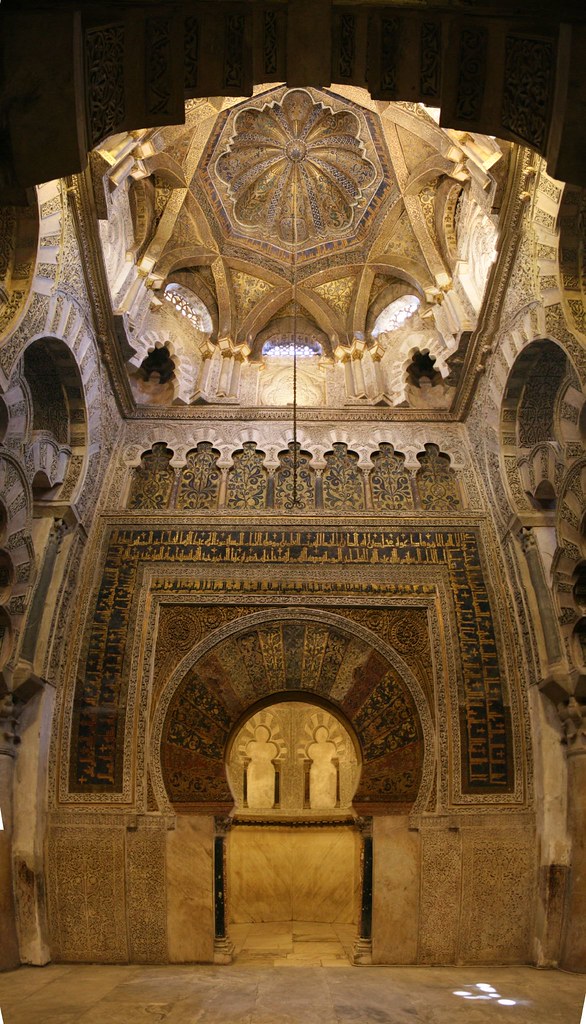
The Hypostyle Hall
The building itself was expanded over two hundred years. It is comprised of a large hypostyle prayer hall (hypostyle means, filled with columns), a courtyard with a fountain in the middle, an orange grove, a covered walkway circling the courtyard, and a minaret (a tower used to call the faithful to prayer) that is now encased in a squared, tapered bell tower. The expansive prayer hall seems magnified by its repeated geometry. It is built with recycled ancient Roman columns from which sprout a striking combination of two-tiered, symmetrical arches, formed of stone and red brick.
The Mihrab
The focal point in the prayer hall is the famous horseshoe-arched mihrab or prayer niche. A mihrab is used in a mosque to identify the wall that faces Mecca—the birthplace of Islam in what is now Saudi Arabia. This is practical as Muslims face Mecca during their daily prayers. The mihrab in the Great Mosque of Cordoba is framed by an exquisitely decorated arch behind which Gold tesserae (small pieces of glass with gold and color backing) create a dazzling combination of dark blues, reddish browns, yellows and golds that form intricate calligraphic bands and vegetal motifs that adorn the arch.
The Horseshoe Arch
The horseshoe-style arch was common in the architecture of the Visigoths, the people who ruled this area after the Roman empire collapsed and before the Umayyads arrived. The horseshoe arch eventually spread across North Africa from Morocco to Egypt and is an easily identified characteristic of Western Islamic architecture (though there are some early examples in the East as well).
The Dome
Above the mihrab, is an equally dazzling dome. It is built of crisscrossing ribs that create pointed arches, all lavishly covered with gold mosaic in a radial pattern. This astonishing building technique anticipates later Gothic rib vaulting, though on a more modest scale. The Great Mosque of Cordoba is a prime example of the Muslim world’s ability to brilliantly develop architectural styles based on pre-existing regional traditions. Here is an extraordinary combination of the familiar and the innovative, a formal stylistic vocabulary that can be recognized as “Islamic” even today.
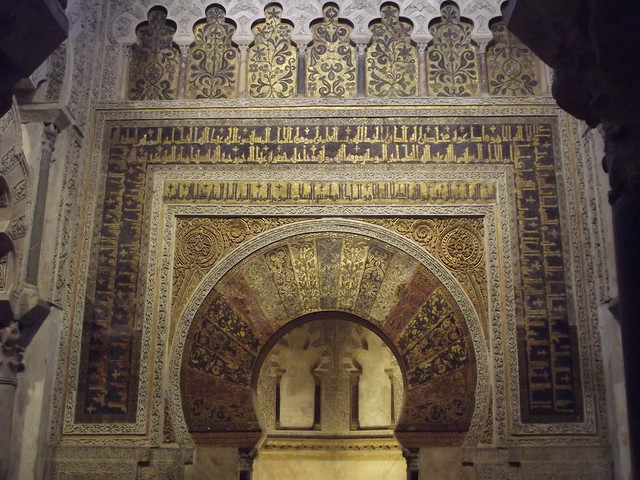

Media Attributions
- Figure 1. The Great Mosque at Cordoba exterior (Images Source: Richard Mortel, via Flickr) is licensed under a CC BY (Attribution) license
- Figure 2. Great Mosque of Cordoba from the Air (Image source: Ulamm via Wikimedia Commons) is licensed under a CC BY-SA (Attribution ShareAlike) license
- Figure 3. Panoramic view of the Hypostyle Hall, Great Mosque at Cordoba, Spain, begun in 786 and enlarged during the 9th and 10th centuries (Image source: Richard Mortel via Flickr) is licensed under a CC BY-NC-SA (Attribution NonCommercial ShareAlike) license
- Figure 4. Mihrab dome, Great Mosque at Cordoba. Interior, View of the maqsura; ribbed vault before mihrab and zone of transition, stone (Image source: Bongo vongo via Flickr) is licensed under a CC BY-SA (Attribution ShareAlike) license
- Figure 5. Detailed view of a horseshoe arch at the Great Mosque at Cordoba (Image source: Elliott Brown via Flickr) is licensed under a CC BY-NC (Attribution NonCommercial) license
- Figure 6. Inside the dome at the Great Mosque at Cordoba (Image source: Anna and Michel via Flickr) is licensed under a CC BY (Attribution) license
Candela Citations
- About chronological periods in the Islamic world. Authored by: Dr. Elizabeth Macaulay-Lewis. Provided by: Smarthistory. Retrieved from: https://smarthistory.org/about-chronological-periods-in-the-islamic-world/. License: CC BY-NC-SA: Attribution-NonCommercial-ShareAlike
- The Great Mosque of Cu00f3rdoba. Authored by: Dr. Shadieh Mirmobiny. Provided by: Smarthistory. Retrieved from: https://smarthistory.org/the-great-mosque-of-cordoba/. License: CC BY-NC-SA: Attribution-NonCommercial-ShareAlike

